How do marketing automation strategies help brands scale personalization?
Published on November 20, 2025/Last edited on November 20, 2025/11 min read
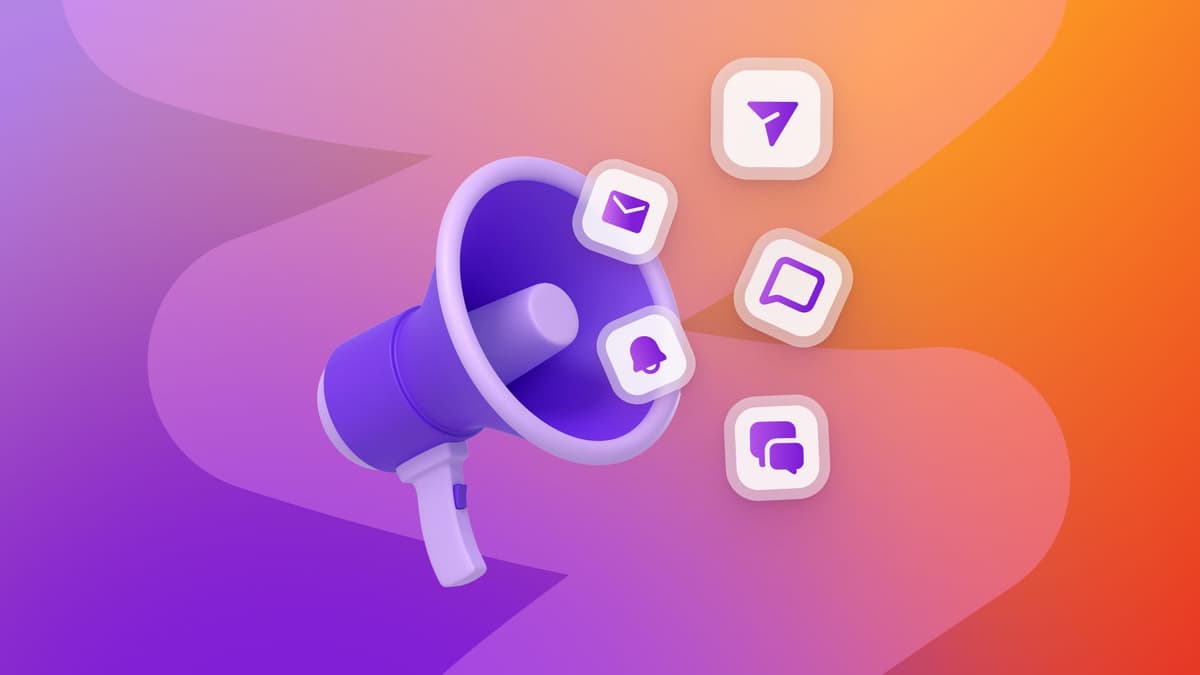
Published on November 20, 2025/Last edited on November 20, 2025/11 min read

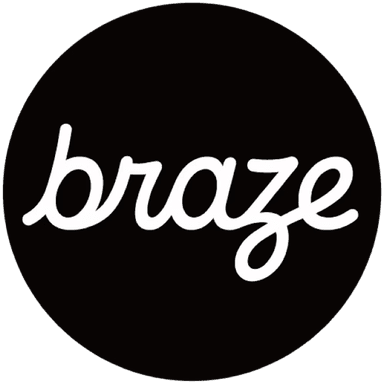
Brands have more channels, data, and customer touchpoints than ever before. What they need is a way to connect them—so every message builds on the last instead of starting from scratch.
Across industries, many are turning to AI to do more of the work behind the scenes. Nearly half of marketing leaders (47%) use or plan to use AI to automate repetitive tasks, while others rely on it to optimize strategies in real time or personalize campaigns.
A marketing automation strategy helps teams coordinate campaigns, reduce manual work, and deliver experiences that stay consistent and relevant across every channel. It also helps nurture leads through every stage of the journey—from first touch to loyal customer.
A recent study found that deploying marketing automation delivered an average return of $5.44 for every dollar spent across the first three years, so when used effectively, automation can create a direct path from customer insight to meaningful and profitable engagement.
Contents
What is a marketing automation strategy?
Why do marketing automation strategies matter for modern teams?
How to implement marketing automation
What are the most effective marketing automation tactics?
What are best practices in marketing automation?
How AI decisioning transforms marketing automation
What are examples of effective automation workflows?
How do you measure success in marketing automation?
Final thoughts on marketing automation strategies
FAQs about marketing automation strategies
A marketing automation strategy is a plan that uses software and data to automate repetitive and time-consuming marketing tasks. It defines which activities can be automated, how success will be measured, and how automation supports broader marketing goals.
These tasks often include email campaigns, audience segmentation, lead management, and reporting. By automating these areas, teams can focus less on manual setup and more on creating personalized experiences that reach the right audience at the right time.
When data, goals, and technology align, automation gives marketers a reliable system for building customer engagement at scale.
Marketing automation strategies matter for modern teams because real-time, data-driven marketing has made automation essential. With audiences moving between channels and devices constantly, manual coordination can’t keep up. Automation gives teams the structure to respond to behavior as it happens and keep communication consistent at scale.
Brands using marketing automation often see higher open and click-through rates, better conversion rates, and lower customer acquisition costs. More importantly, they can identify valuable customer moments in real time and act on them instantly.
A strong automation framework is tailored to each business’s data, goals, and customer journeys. The next step is knowing how to build it.
An effective marketing automation strategy begins with knowing your audience and the outcomes you’re aiming for. From there, you can shape a framework that’s flexible and measurable.
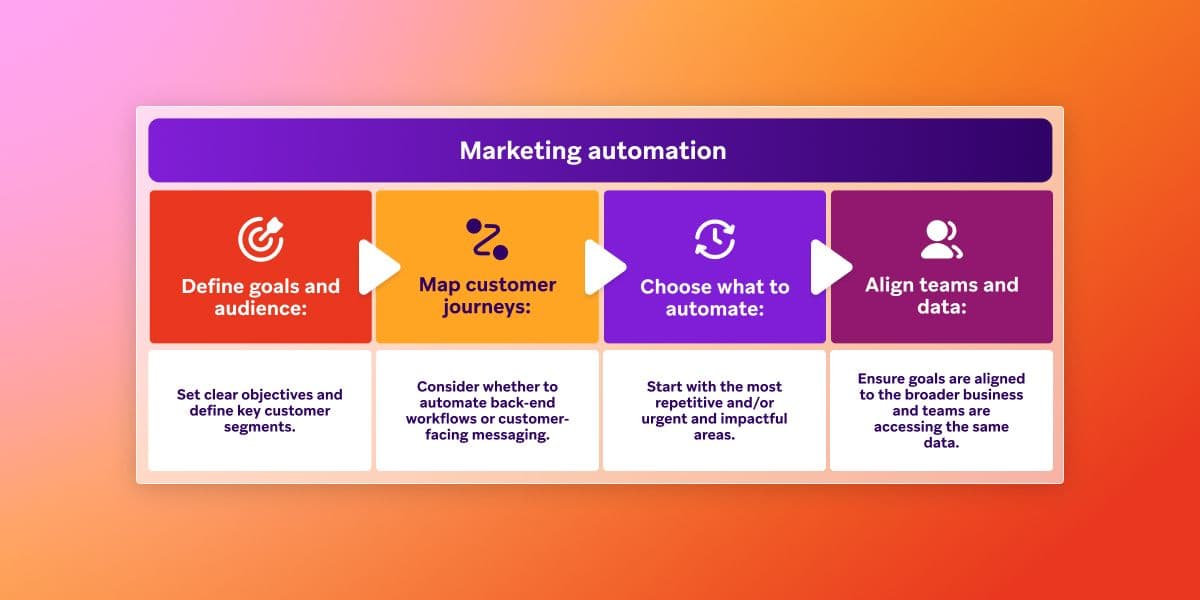
Start by setting clear, measurable objectives—whether that’s higher conversion rates, improved retention, or stronger engagement. Then focus on your audience. Identify key customer segments and define your target audience based on behavior, preferences, and value. These insights will guide what you automate and how you communicate at each stage of the journey.
Automation works best when it follows the customer’s path. Map out key moments in their journey—from awareness to purchase to loyalty—and identify which messages add value at each stage.
Consider two types of automation:
Not every process needs automation. Start with repetitive, time-sensitive tasks that have a clear impact on performance. Examples include:
Prioritize areas where automation can save time while improving customer experience.
Marketing, product, and analytics teams should share goals, KPIs, and unified data. This alignment makes it easier to personalize messages, measure results accurately, and avoid duplicated effort.
With goals defined and teams aligned, it’s time to turn strategy into action through the right mix of solutions and tactics.
The most effective marketing automation tactics connect data, decisioning, and delivery. They use insight to trigger the right action, and help brands run co-ordinated marketing campaigns.
With the right marketing automation tools, brands can:
These tactics create a foundation for meaningful automation. Each one helps brands automate repetitive tasks without losing relevance or creativity, keeping marketing responsive and customer-led.
The best practices that stay true to this customer-led approach rely on strong data foundations and consistent attention to how customers interact and change over time. Here are the right habits to form:
Every automated message starts with reliable data. Regularly audit data sources, remove duplicates, and keep integrations consistent to maintain trust and precision.
Group customers based on lifecycle stage, preferences, or predicted value. Thoughtful segmentation keeps communication relevant and focused.
Focus marketing efforts on the customers who show the strongest intent or engagement. This approach drives efficiency and strengthens overall performance.
Identify key moments from onboarding to re-engagement. Mapping helps connect individual campaigns into a seamless experience across every channel.
Automate messages that respond directly to customer actions—like signing up, making a purchase, or viewing a product—to keep timing and context aligned.
Track how automations are performing against goals such as open rate, click-through rate, or conversion rate. Spot patterns early to stay proactive.
Review automation logic regularly. Adjust triggers, timing, or audience rules to reflect new products, changing preferences, or seasonal behavior.
Experiment with content, channels, and timing. Continuous testing helps teams optimize campaigns and uncover what motivates each audience segment.
Encourage collaboration between marketing, product, and analytics teams. A shared view of data keeps messages consistent and decisions grounded.
Automation increases speed, but empathy and creativity build connection. Use data to inform decisions—then add the human touch where it matters most.
Track outcomes that reflect true impact, like retention, revenue, and customer lifetime value.
Automation improves over time. Keep learning, experimenting, and adopting new technologies to make your strategy smarter and more responsive.
These practices create a foundation for marketing automation that’s flexible, measurable, and ready for what comes next—AI-driven decisioning that adapts to every customer moment.
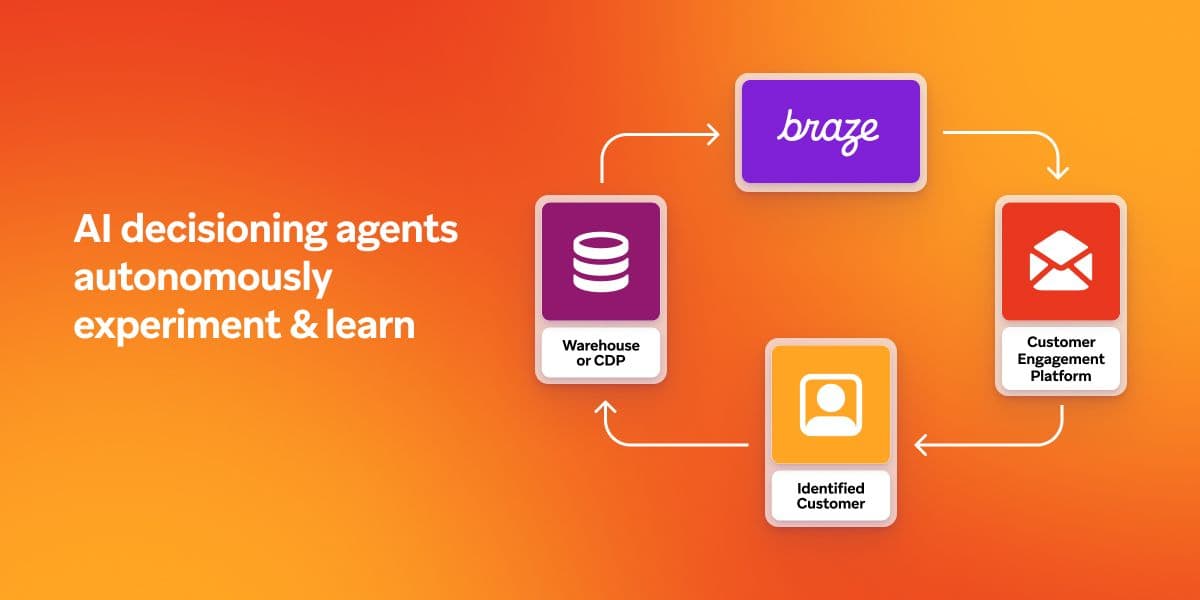
AI decisioning represents the next step in marketing automation—evolving from static workflows to systems that learn in real time. Rather than following fixed segments or pre-set schedules, it adapts with every customer action to deliver messages that feel timely and relevant.
With BrazeAI Decisioning Studio™, this intelligence sits at the center of your engagement strategy. Acting as the “brain” between data and delivery, it determines the best message, channel, moment, and send time for each individual—then orchestrates that decision instantly across email, push, SMS, and in-app messaging.
Because it’s built on reinforcement learning, the system experiments across multiple variables—creative, timing, and offer type—and uses live feedback to keep improving results. That includes optimizing send times automatically, so messages arrive when each customer is most likely to engage.
For example, a retail brand might use AI decisioning to adjust offer timing based on store inventory or a customer’s browsing habits, while a travel app could shift notifications dynamically according to destination, weather, or flight status.
For marketers, that shift means less manual setup and faster impact. AI handles the constant optimization, freeing teams to focus on strategy and storytelling.
Clear goals and customer intent are essential for creating an effective workflow. These examples drive engagement and retention:
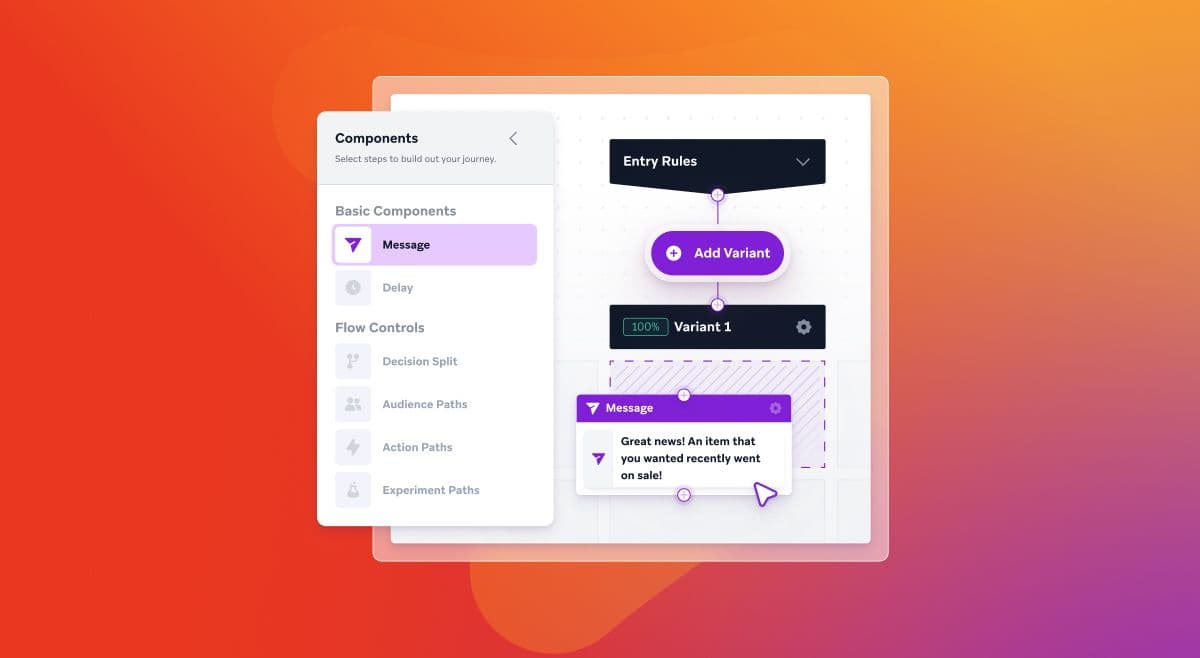
Each workflow creates an opportunity to turn insight into action and deepen customer relationships over time.
Measurement turns automation into a learning system. Tracking the right metrics reveals what drives engagement, where customers drop off, and how campaigns contribute to growth.
Focus on metrics that link directly to outcomes:
These insights turn data into direction, helping marketers refine targeting, test new triggers, and improve the customer experience over time.
The impact of marketing automation depends on the technology behind it. The best platforms connect data, orchestration, and AI in one place—making it easier for teams to move from insight to action in real time.
When evaluating marketing automation tools, look for capabilities that support both scale and personalization:
Brands who have chosen Braze are able to combine data, orchestration, and AI decisioning in one place. Here’s how Kayo Sports leveraged AI to create 1:1 messaging at scale, driving customer loyalty and lifetime value in the process.
Kayo Sports is Australia’s leading sports streaming platform, giving fans access to more than 50 sports live and on demand. With a growing subscriber base and thousands of hours of content, Kayo wanted to keep fans engaged long after sign-up—and reduce the manual work needed to do it.
Traditional segmentation and static rules limited Kayo’s ability to personalize at scale. Campaigns were effective but labor-intensive, and the team needed a faster, smarter way to match every fan with the right message, timing, and offer.
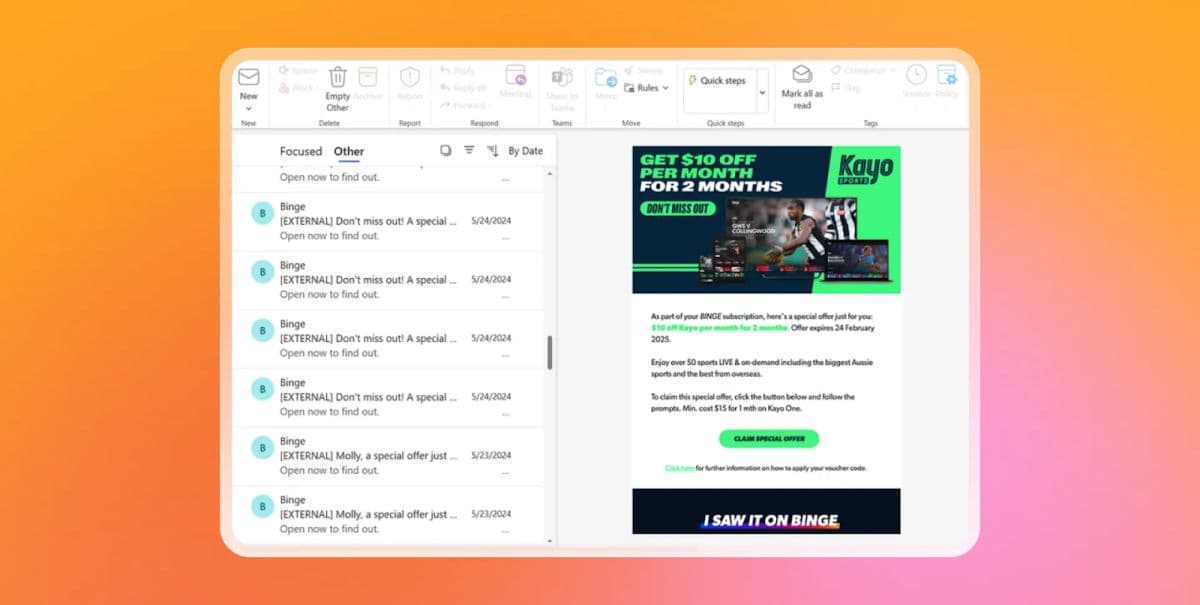
Kayo turned to Braze and BrazeAI Decisioning Studio™ to automate decision-making and scale personalization. By combining real-time customer data with AI decisioning, Kayo created a “Customer Cortex”—an intelligent system that learns from every interaction.
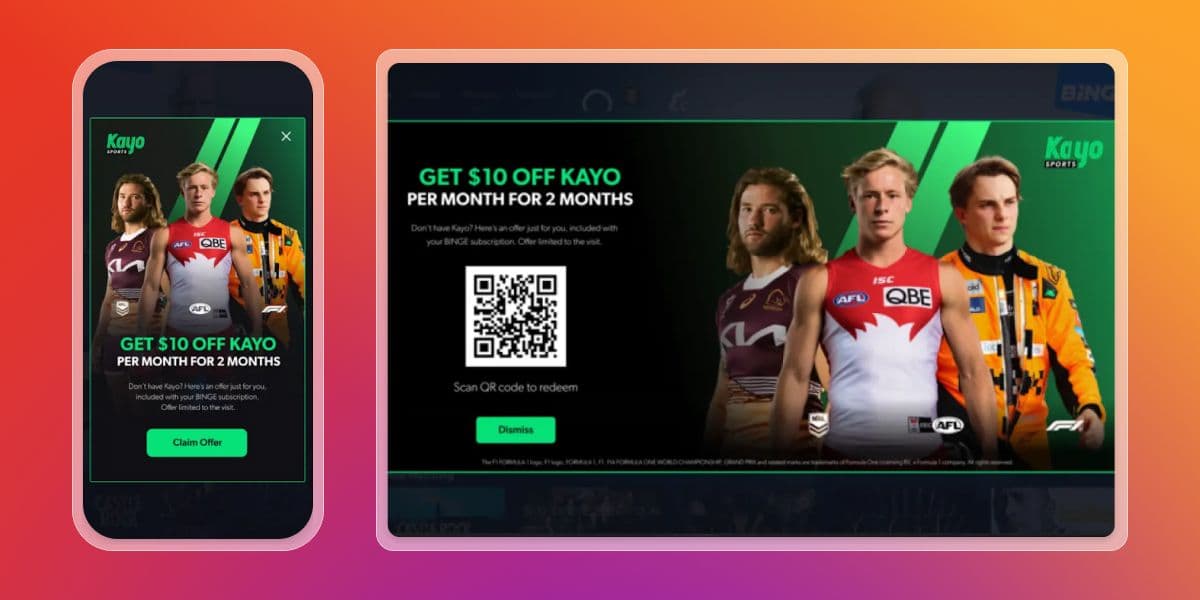
The impact was signficant:
Kayo’s automation framework now runs like a living system—continuously learning, adapting, and engaging fans wherever they are.
Marketing automation has become the engine behind more personalized, efficient communication. It helps teams use insight to adapt quickly, deliver relevance, and keep campaigns improving with every interaction.
AI decisioning takes that capability further—introducing intelligence that learns from every response and adjusts campaigns in real time. Combined with human creativity, it creates a system built for continuous growth and more meaningful relationships.
With the right foundation and solutions like Braze, automation turns everyday marketing into ongoing conversation—responsive, connected, and ready for what’s next.
Marketing automation strategies are structured plans that use data and technology to automate marketing tasks, improve personalization, and strengthen customer engagement.
Marketing automation strategies can improve performance by increasing efficiency, improving targeting, and helping teams send relevant messages at the right time—boosting conversion and retention rates.
What tools are used in marketing automation?
Common tools used in marketing automation platforms include ones that handle email, SMS, push, and in-app messaging with integrated data and analytics. These tools automate workflows and measure results in real time.
To start building a marketing automation strategy, begin by setting goals, mapping customer journeys, identifying high-impact automations, and choosing a platform that unifies data across channels.
AI is important in marketing automation because it makes automation adaptive. It uses predictive models to optimize timing, channel, and content for each customer, turning static workflows into personalized experiences.
Sign up for regular updates from Braze.




